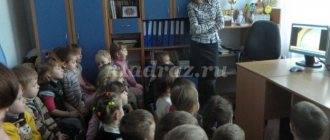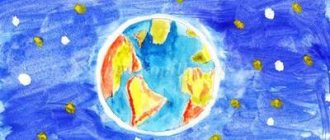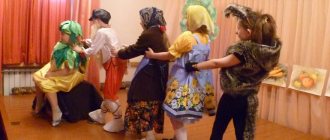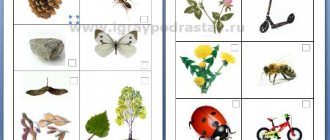Summary of the open lesson “Our favorite fairy tales” in the senior group
Bereza Olga
Summary of the open lesson “Our favorite fairy tales” in the senior group
Summary of an open lesson in the senior group “ Our favorite fairy tales ”
Goal: to instill a sustainable interest in fiction.
1. Clarify and enrich children’s knowledge about fairy tales .
2. Learn to recognize a fairy tale by assignment .
3. Learn to convey the structure of a fairy tale using modeling.
2. Develop the ability to act in concert.
3. Develop speech, imagination, fantasy, thinking.
Educational tasks: To cultivate an interest in reading, a love of oral folk art.
Preliminary work: Reading fairy tales , children's retellings , exhibition of drawings, conversations.
Educator: Hello guys!
Today we will talk about fairy tales . Look how many interesting books we have collected here!
Progress of the lesson
Presenter: Hello, children! It’s so good that you came to our clearing of fairy tales . I 'll show you a lot of interesting things . Follow me! (Leads them slowly to the first plot)
- Look, children. Who lives here? (grandmother and grandfather)
- That's right, grandpa and grandma. And they have pockmarked chicken. What did the chicken lay for them? (Testicle)
- Which egg? (Golden)
- Now tell me, what is the name of this fairy tale ? (Chicken Ryaba)
If the children find it difficult to answer, the presenter continues to tell the story . Now the children will call it unmistakably.
After praising the children, the presenter offers to watch and say the name of another fairy tale .
Host: What a house in the forest! What interesting people live in this house! And everyone lives together, sings songs cheerfully. Call them all in order.
- Who is upstairs? She is happy that she can see everything from above. (Frog)
- Who is sitting here? (Bunny)
- That's right, there's a jumping bunny sitting here.
Each time, as soon as the children name the character, the presenter gives its exact definition from the fairy tale : little fox-sister, gray top, bear-toptyshka, which helps the kids remember the fairy tale .
Host: We looked at everyone in this cute house. Now remember what the fairy tale ?
(He begins a fairy tale until one of the children names it .
It’s already cold and the little animals came running into the tower. You guys are great, you know a lot of fairy tales ! 'll show you another , let's all go together)
Leads children to the plot of “Kolobok”
, look at her.
- What is the name of the fairy tale ? (Kolobok)
- Where does the fairy tale ? (Grandma baked a kolobok)
— What did grandma do after she baked Kolobok? (Put it on the window)
— Kolobok rolled into the forest , and who did he meet first? (Hare)
- What did Kolobok answer him? (I will eat you)
- Whom did Kolobok meet later, after the bunny? (Called)
So about all the heroes.
- Let's sing the song "Koloboka"
.
(Singing)
- Who was the last person he met? (Little Chanterelle)
- What did the fox do? (Attened by Kolobok)
2. D/game “Put out the fairy tale Kolobok ”
Educator. Look at the fairy tale depicted in the pictures. Arrange the cards in order, what happened first and what came next.
- Which card should we put down first? What happened next? Who did you meet - a hare, a wolf, a bear, a fox? (Children lay out cards)
-How did the fairy tale ? (The fox ate Kolobok)
3. Physical exercise. "Kolobok is rolling along the path"
4. Modeling with elements of drawing.
"Kolobok is rolling along the path"
Goal: Continue to teach children to create images based on folk tales . Combine different techniques: drawing a path in the form of a curved line with felt-tip pens and sculpting a Kolobok in the shape of a ball. Arouse interest in “revival”
Koloboka (beady eyes or buttons.
Educator. Invites children to choose plasticine as they wish and mold their own cheerful Kolobok. Children make Koloboks.
The teacher shows Kolobok in the window (puppet theater )
and reads an excerpt from the poem.
V. Shipunova “Kolobok-Kolobok”
Kolobok-Kolobok, Put a Kolobok
He has a ruddy side. Cool in the window.
And he is good and handsome, Kolobok from the window - hop!
And he looks like the sun! Rolled along the path .
Offers a piece of light green paper and draws a long path. He reports that Kolobok will now roll - to the surprise of the animals, towards adventure! Children draw their own paths for Kolobok.
Then they take their Koloboks and roll along the drawn paths.
Educator. So our journey through fairy tales . Now we are returning to kindergarten.
"Journey to the land of fairy tales." Open lesson on speech development in the senior group Topic: “Journey to the land of fairy tales” Integration of OO: Cognition, communication, fiction. Goal: to consolidate children’s knowledge about Russians.
Synopsis of continuous educational activities for the development of speech through theatrical activities “On the roads of fairy tales” Synopsis of continuous educational activities for the development of speech through theatrical activities along the roads of fairy tales in the second junior.
Abstract of the educational activity for the development of speech “A cat visiting” in the senior group Purpose: Generalization and systematization of children’s knowledge about a domestic animal, its adaptability to the environment, benefits for humans and development. Summary of educational activities on speech development in the senior group “Casket of Fairy Tales” Objectives: Educational: teach to recognize a fairy tale from riddles, illustrations, expand the subject’s vocabulary;
Summary of an open lesson on speech development “Journey to the Land of Fairy Tales” Goal and objectives: - create conditions for consolidating children’s knowledge about Russian folk tales; - create conditions for the formation of the ability to recognize.
ECD for Speech Development “Visiting a Fairy Tale” Goal: Creating conditions for the development of speech of preschool children through play activities and introduction to oral folk art. Tasks:.
Speech development project “Visiting a fairy tale” Hypothesis: introducing children to a fairy tale improves the child’s mind, helps master speech, learn about the world around him, and develops a stable one.
Source
Mathematical tales
And Krug’s friend, on the contrary, was calm, serious and reasonable. He stood very firmly on his feet, was never in a hurry and, almost always, was bored and alone, because Krug was rushing somewhere on the right, then rolling down the mountain to the left and was never with him. And in the city of Geometric Figures his name was Square, and he was respected for his constancy and modesty.
When friends quarreled, Krug scolded Kvadrat for his slowness and clumsiness. Sometimes Kvadrat would get offended and mutter angrily: “It’s good for you, you’re round and smooth, you roll like a bun and never stop when you’re asked. You can only stop when they trip you up or you run out of strength.” But I only know how to roll from side to side. I have sharp corners, and I have four of them (demonstration and display). So they interfere with movement.”
When Krug realized that he had offended his friend, he began to calm him down. “Don’t be upset, my friend, the reason you are a square is because you have four beautiful right angles. And if it weren’t for them, you would be the same as me. And everyone should be themselves. I believe that the Square is much more useful for people than the Circle. Just imagine a car without wheels. This is a car in need of repair. Now imagine wheels without a car. Wheels are wheels. This is just a small part to make the car move.”
Kvadrat listened attentively to his friend and thought: “Thank you, Krug, for the consolation. You say everything correctly, but you just don’t know one thing - if it weren’t for circles and wheels, we would still be walking, waddling from side to side, at a snail’s pace, and we would never did not reach the city of Geometric Figures. »
Fairy tale: Visiting the Queen of Mathematics.
This story happened in one city. With a very ordinary boy, whose name was Seryozha. Like all boys who turned 6 years old, Seryozha loved to play with toy cars more than anything in the world. In the summer the boy played football with friends, and in the winter he played hockey. Serezha’s parents often said that he would soon go to school in the 1st grade. But the boy did not want to go to school. He enjoyed going to kindergarten. One day on a day off, his younger sister Ira came up to Seryozha and handed him a box of sweets. “Seryozha, help me, I can divide the candy equally,” the girl asked. Ira was 2 years younger than her brother and did not yet know how to count. Seryozha, narrowing his eye, began to count out loud. 1, 2, 3, 4, 5 - this is for me - Seryozha said proudly. 1, 2, 3, 4, 5 - this is for you - the boy continued. But in the box there were still delicious and aromatic candies wrapped in beautiful candy wrappers. Seryozha continued to put candy in his pile. And when there were no sweets left in the box, the boy said cheerfully: Well, that's all! Ready! Ira looked at her brother and asked: Are you sure you divided the candies equally? - Certainly! Still asking! – Seryozha answered, slightly embarrassed. - I can count. Take your sweets and go eat,” the boy said authoritatively. - Thank you! – Ira exclaimed joyfully. Seryozha looked at the large pile of sweet candies and smiled. I deftly outwitted Irishka, thought Seryozha. Then my grandmother came into the room. She looked sternly at her grandson. - Seryozha, you took more sweets for yourself, and Ira asked you to divide the sweets equally. - Maybe you don’t know how to count? – the grandmother asked sadly. - I can! I can! – Seryozha assured his grandmother, “What’s so hard about that?” One, two, three and you're done. “Well, then one of two things remains,” the grandmother continued to say. Or did you deliberately deceive your sister, or did you accidentally make a mistake in counting? It would not hurt you, granddaughter, to go to the Land of Knowledge. - Oh, where is such a country located? – Seryozha was surprised. Grandmother smiled and answered: When I was a little girl, I also didn’t know how to count, and I didn’t want to solve examples and problems. But one day I opened one secret door and found myself in the Land of Knowledge. - Grandma, I also want to go to the Land of Knowledge! - Seryozha shouted. - It’s too early for you! “You don’t want to go to school,” the grandmother answered and left the room. Seryozha was left alone. He no longer wanted to play with cars. The boy began to think, where is this very door that leads to the land of Knowledge? Seryozha tiptoed out of the room and headed to the room where his grandmother lived. The boy quietly opened the door and found himself inside the room. He looked around, everything was in its place: closet, bed, bedside table, table, bookshelves. Seryozha's attention was attracted by a large painting that hung in the middle of the room. The painting depicted an unusually beautiful, antique, carved door. In the reflection of the sun, the door sparkled and shimmered with a golden color. An interesting door, Seryozha thought and came closer. Up close, the door turned out to be even more massive and mysterious. The boy looked at the picture with admiration. The door handle caught his attention. It was gracefully curved and resembled the neck of a swan. The boy grabbed the handle and the door creaked. Slowly but surely the door began to open slightly. Seryozha, barely coping with curiosity, looked behind the door. On the other side of the door stood small numbers and looked at the uninvited guest with interest. In fairyland, numbers could walk and talk. They had small legs, arms, eyes and mouths.




